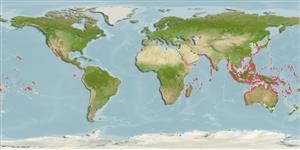Common names from other countries
Environment: milieu / climate zone / depth range / distribution range
বাস্তুসংস্থান
; গভীরতার পরিসীমা 1 - 8 m (Ref. 101216). Tropical
Indo-Pacific.
Length at first maturity / আকৃতি / ওজন / Age
Maturity: Lm ? range ? - ? cm Max length : 4.0 cm SHL পুরুষ/ লিঙ্গ অনিধর্ারিত ; (Ref. 349); common length : 3.0 cm SHL পুরুষ/ লিঙ্গ অনিধর্ারিত ; (Ref. 349)
Mainly collected for shellcraft. Formerly used as a currency in many areas of the world, the shell is also still used as a divinatory item by some animist tribes, particularly in tropical Africa. Empty shells of Cypraea annulus collected outside this area were carried there by ships when to his cowry was used as a currency (Ref. 349). Widespread in the shallow water, occurring in every kind of habitat (Ref. 349). Members of the family Cypraeidae are primarily carnivores (Ref. 67623).
Life cycle and mating behavior
পরিপক্কতা | প্রজনন | ডিম ছাড়া | ডিমসমূহ | ডিম্বধারন ক্ষমতা | শুককীট
Members of the order Neotaenioglossa are mostly gonochoric and broadcast spawners. Life cycle: Embryos develop into planktonic trocophore larvae and later into juvenile veligers before becoming fully grown adults.
Poutiers, J.M. 1998. (Ref. 349)
IUCN Red List Status (Ref. 130435)
CITES status (Ref. 108899)
Not Evaluated
Not Evaluated
Threat to humans
Harmless
Human uses
মৎস্য: বাণিজ্যিক
| FishSource |
হাতিয়ার
আরো তথ্য
Age/Sizeবৃদ্ধিLength-weightLength-lengthবহিঃ অঙ্গ সংস্থানশুককীট প্রাচুর্য
ইন্টারনেট সুত্র
Estimates based on models
Preferred temperature
(Ref.
115969): 23.5 - 29.3, mean 28.4 (based on 3364 cells).
Vulnerability
Low vulnerability (10 of 100).
Price category
Unknown.
